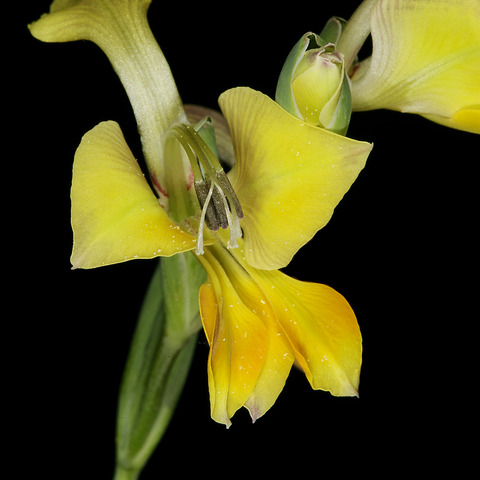Plants 120-200 mm high [excluding basal leaf]. Corm globose to depressed-globose, 12-15 mm diam.; tunics soft-papery becoming fibrous, seldom persisting. Stem ± erect below, flexed outward and inclined in middle but sometimes ± erect below spike, seldom branched. Leaves 3(5), lowest much longer and ± as long to twice as long as stem, linear to terete, 1-3 mm wide, oval to round in section with margins raised and edges arching toward main vein, main and often one other vein also raised, thus 2-or 3-grooved on each surface, remaining leaves short, lowermost sheathing lower half of stem, uppermost inserted in upper half of stem and distant from lower, usually bract-like without blade, sheaths and sometimes blades sparsely to densely scabrid to pubescent on veins. Spike flexed at base, inclined, fairly straight or lightly flexuose, 3-to 7(12)-flowered; bracts green, veins ± transparent, outer 20-30 mm long, inner shorter and ± enclosed by outer. Flowers yellow to yellow-green or pink, upper 3 tepals flushed or feathered green, brownish purple or dark pink, lower 3 tepals with deep yellow to white band across base of limb, pale distally and sometimes mauve or pink apically, sutures between tepals thickened into densely papillose iridescent ridges, strongly violet-scented or unscented (some pink-flowered plants); perianth tube narrowly and obliquely funnel-shaped, 9-12(-15) mm long; tepals with dorsal longest, ± spathulate, straight and inclined or erect, margins sometimes recurved, 20-40(-48) x 10-16(-20) mm long, narrowed below and claw-like for ± 18 mm, upper 1/3 abruptly expanded and triangular, upper laterals spade-shaped, base narrow and claw-like for, 1-3 mm, limbs abruptly expanded, triangular, curving outward distally, 14-25(-30) mm long, lower 3 tepals joined to upper laterals for ± 5 mm and together for 1-3 mm, free parts 16-20(-30) mm long, clawed, narrow and grooved below, abruptly expanded into limbs 10-12(-20) mm long. Filaments strongly arched, 18-27 mm long, exserted for 15-22 mm; anthers 6-8 mm long, pale or dark; pollen yellow. Style arched over stamens, dividing opposite upper 1/3 of anthers, branches 4-6 mm long. Capsules oblong-ellipsoid, 18-25(-30) mm long. Seeds ovate to round, 5-7 x 5-6 mm, broadly and evenly winged.
More
Perennial herb, geophyte, 0.10-0.25 m high; corm (depressed-)globose, tunics soft papery becoming fibrous; stem ± erect below, flexed, inclined, seldom branched. Leaves 3(-5), linear to terete, scabrid, 1-3 mm wide, margins raised, edges arching toward raised midribs. Bracts green; veins ± transparent. Inflorescence a 3-7(-12)-flowered spike, straight or lightly flexuose; flowers yellow to yellow-orange or pink; upper 3 tepals flushed green, brownish purple or dark pink; lower 3 tepals with deep yellow to white band across base and pale distally; perianth tube narrowly and obliquely funnel-shaped; tepals unequal; the dorsal longest, ± spathulate, margins recurved. Stamens exserted; anthers pale or dark; pollen yellow. Ovary oblong; style arching over stamens. Flowering time Aug., Sept. Capsule oblong-ellipsoid.
Cormous geophyte, 10-25 cm, tunics papery. Leaves linear and ribbed to terete. Flowers bilabiate, dorsal tepals erect, yellow to pink with dark veins, fragrant.

